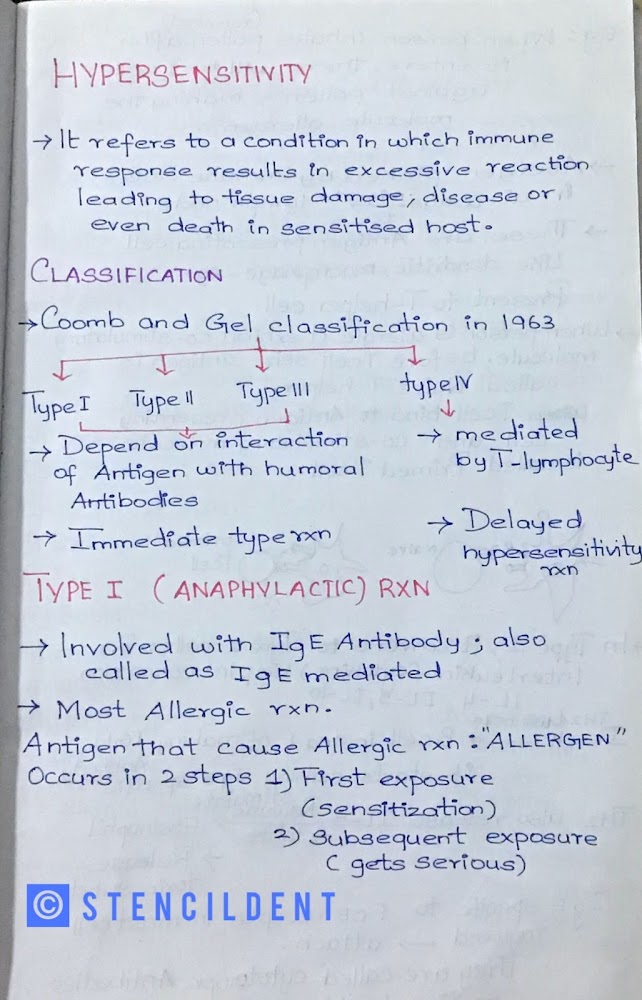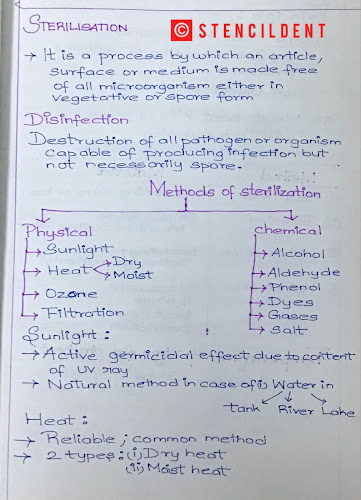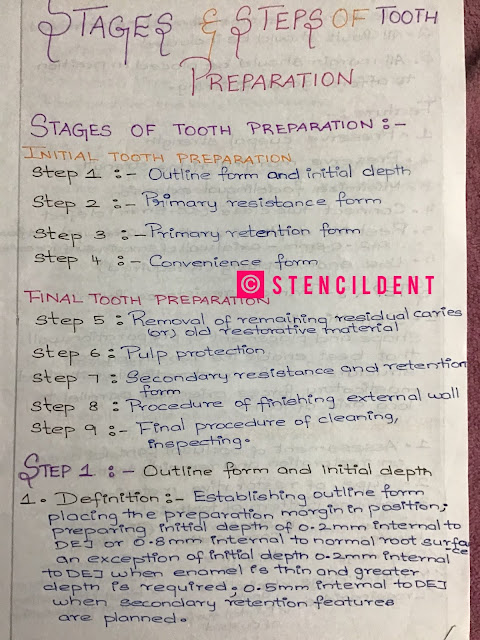Hypersensitivity microbiology notes
HYPERSENSITIVITY
hello, doctor vanakam,
I hope you all are doing good, as intimated through the last post on anaerobic culture method https://www.stencildent.com/2020/08/anaerobic-culture-methods-microbiology.html if u haven't checked it out do read using this link without any further ado lets get started.
CONTENTS:
1)Definition
2)Classification
3)type 1 hypersensitivity reaction
a)1st exposure
b)2nd exposure
c)mediators of reaction
d)late-phase reaction
4)type 4 hypersensitivity
5)treatment
1)DEFINITION:
It refers to a condition in which immune response results in excessive reaction leading to tissue damage, disease, or even death in a sensitised host.
2) CLASSIFICATION:
- Coomb and gel classification in 1963 into type 1 to 4
- Type 1, type 2, type 3 :
- They depend on the interaction of antigen with humoral antibodies
- They are the immediate-type reaction
type 4 :
- They are mediated by t lymphocyte
- Delayed-type of hypersensitive reaction
3)TYPE 1 (ANAPHYLACTIC )REACTION :
- They are involved with the IgE antibody , also called an IgE mediated type of reaction.
- The most allergic reaction
- An antigen that causes an allergic reaction: allergen
- It occurs in 2 steps: 1)first exposure (sensitization), 2)subsequent exposure
a) first exposure
- eg)When a person inhales pollen after it enters there will be t cells against the pollen making the molecule allergen
- Allergen picked by immune cells in airways migrate to lymph node
- These are antigen-presenting cells like dendritic cells, macrophage that present to t helper cell
- When a person is allergic it exhibits co-stimulatory molecule, before t cells seize antigen is called naive t helper
- When t cell bind to the antigen-presenting cell and co-stimulatory molecule is called primed t cell
- In type 1 it converts to type 2 cell or t helper 2, interleukin (cytokine) help in conversion IL-4,IL-5, IL-10
- B cell instead of making Ig M specific antibody it starts making IgE specific antibody
- T helper 2 also release interleukin -5 that stimulate and activate eosinophil and release a toxic substance
- Ig E specific to Fce receptor in mast cell gets attached they are called cytotrophic antibodies as they bind to antigen surface
b)2nd exposure:
Few months , later during 2nd exposure , the antibody binds to an antigen they get cross-link and degranulate pro-inflammatory mediators producing an allergic reaction.
c) MAJOR MEDIATORS:
- Histamine bind to h1 receptor resulting in bronchi smooth muscle to contract this further leads to difficulty in breathing and also because of blood vessel dilation , increase in permeability results in edema, urticaria
- Eosinophil
- Protease
d)late-phase reaction: 8-12 hours
Eosinophil,t helper 2 cells,and basophil are recruited to site where an allergen is located
mild symptoms are urticaria, eczema, allergic rhinitis 9inflammation in the nose , asthma
severe symptoms include increase n vascular permeability, airway constriction and may result in anaphylactic shock
4)TYPE 4 HYPERSENSITIVITY :
- Its a delayed type of hypersensitivity, after 48-72 hours of exposure
- Cell-mediated response
- immune system elements are:
- 1)Antigen-presenting cell
- 2) Major histocompatibility class 2
- 3)Helper t cells: Based on glycoprotein present on the surface
- a)CD4+ glycoprotein they are known as helper t cells and present MHC class 2
- b) CD 8+ glycoprotein: they are known as killer t cells and present MHC class 1
- phases:
- Sensitization phase:
- When an antigen enters our body it doesn't produce any reaction unless it binds to hapten and then causes an immune response
- When an antigen enters the body the dendritic cells engulf them and act as an antigen-presenting cell with the help of major histocompatibility complex class 2 on their surface its been recognized by cd 4 cells and t helper cell and secrete interleukin and results in proliferation of cd 4 cells.
2) Effector:
- The proliferation of cd 4 cells results in the formation of interferon-gamma and activates macrophages and release cytokines (tumor necrosis factor, interleukin)
- This gets activated by dd 8 cells and destroys the target organ.
5) treatment:
1) Antihistamine: decrease in bronchoconstriction, and vascular permeability
2)Corticosteroids: decrease the inflammatory response
3)Epinephrine: constrict the blood vessel
GENERAL TALK:
Vanakam, today we have discussed about hypersensitivity reaction I would like to share my own experience on sensitivity all of us would be definitely allergic to some products like for me I am allergic to yam , turmeric I know u all might have got shocked, what? turmeric is considered to be antiseptic, how can u be allergic to it well I got your mind voice yes we do exist allergic to turmeric I googled about it in the net it was surprising to me to see that there are people with this allergic and I wasn't the only with this allergy.
UPCOMING POST :
The next post is about thrombosis ; definition,factors favouring thrombus formation and fate of thrombus. I hope you all understood if it had helped you do let me know in the comment section below.
thank you







Kudos
ReplyDeleteThank you 😊
DeleteYou dentistry article is acedamic reference, i write general fun dental blog from Dentsma, thanks.
ReplyDeleteThis post is so informative and makes a piece of very nice information best medical training institute/a>
ReplyDelete